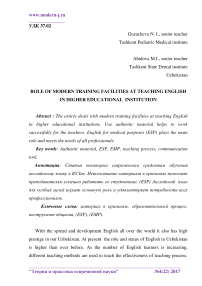Role of modern training facilities at teaching English in higher educational institution
Автор: Guzacheva N.I., Abidova M.I.
Журнал: Теория и практика современной науки @modern-j
Рубрика: Основной раздел
Статья в выпуске: 4 (22), 2017 года.
Бесплатный доступ
Aннотация: Статья посвящена современным средствам обучения английскому языку в ВУЗах. Использование материала в оригинале помогает преподавателям успешно работать со студентами. (ESP) Английский язык для особых целей играет основную роль и удовлетворяет потребности всех профессионалов.
Authentic material, esp, emp, teaching process, communication tool, (esp), (emp)
Короткий адрес: https://sciup.org/140271224
IDR: 140271224
Текст научной статьи Role of modern training facilities at teaching English in higher educational institution
With the spread and development English all over the world it also has high prestige in our Uzbekistan. At present the role and status of English in Uzbekistan is higher than ever before. As the number of English learners is increasing, different teaching methods are used to teach the effectiveness of teaching process.
Use authentic materials in the form of films, multimedia, TV help us to work successfully. The use of new technologies is one of the most significant drivers in teaching process now. The role and status of English is great in education, policy, economics, business, mass media. English also can work as communication tool at international meetings, conferences and so on.
In this aspect English for specific purposes (ESP) can play the main part, that meets the needs of all professionals. It can be Business English, Technical English, English for Art Purposes, Scientific English, English for medical professionals and so on.
ESP has two types of characteristics: absolute and variable. We mainly focus on the absolute characteristics.
ESP makes use of underlying methodology and activities of the given discipline.
ESP is centred on the language appropriate to these activities in times of grammar, lexis, study skills and discourse analysis.
English for Medical Purposes (EMP) can be considered as a specific subbranch of ESP. Distinguishes EMP from other ESP sub-branches are that EMP has its own set of medical discourse. Gylys and Wedding (1983) argued that medical discourse is a particular terminology employed to effectively and accurately achieve a communicative purpose in health care settings such as diagnosis [2]. According to Yang (2005), EMP terminology mostly consists of prefixes and affixes, which should be carefully noted at designing EMP course. Celce-Murcia (2001) states that ESP branches and sub-branches are different to classify since the specific nature of each ESP context is so diverse that there is even an ESP for prisoners [4]. Along the numerous ESP subsections, EMP comes under the umbrella of English for Science and Technology (EST), which is, in turn is a branch of ESP. EMP courses deliver specific communication topics, grammar and discourse. In research literature, Orr (2002) examined a two-year EMP course designed for student nurses at an Australian university which was intended to prepare non-native speaker of English nurses [1]. The main focus of the course was English for admission and registration. The course materials were designed by both a nursing instructor and English teacher, which brings to light the significance of content instructor’s input in designing and delivering and delivering EMP course. In other words, EMP course needs to cover not only the linguistics and communicative features of the topic, but also the content areas related to medical topics such as conversations among patients, doctors and nurses. Regarding the teacher’s role in ESP, Swales (1985) states that ESP teachers must be immensely involved in the content language of the discipline and must be taken with extreme care [5]. Bosher and Smalkowski’s (2002) emphases that the crucial role need analysis plays in determining EMP course selection and delivery. They considered that the needs analysis should be based on interviews with teachers and students, student’s questionnaires about the complexities of the health-care language and observations of different EMP classes. They also found that communication was the main difficulty healthcare students faced. It can than be concluded that EMP curses need to focus on enhancing student’s communicative skills such as speaking and hence EMP materials are represent that trend. Technological innovations go hand in hand with the growth of English and they change the way in which we communicative. It is fair to assert that the growth of the internet facilitates the growth of English language and it has occurred at a tome when computers are no longer the exclusive domains. In connection with it we have very significant proliferation of literature regarding the use of technology in teaching English. Mostly these writings accept technology as the most essential part in teaching, tendency to emphasize the role of technology in pedagogics to extend the human part of teacher by technology part that is very dominant. And as a result if we neglect or ignore technological developments we will never be able to catch up, irrespective of our discipline or branch. For this reasons it is important for language teachers to be aware of the latest and best equipment, to have much knowledge of what is available in any situation. Teachers can use Multimedia
Technology to give more colorful, stimulating lectures and opening new horizons for interesting jobs.
Список литературы Role of modern training facilities at teaching English in higher educational institution
- Orr. A two-year EMP course, Australian university, 2002 (for students nurses)
- Gylys and Wedding Medical discourse is particular terminology, 1983
- Young EMP terminology of prefixes and affixes, 2005
- Celce-Murcia ESP English for sciences and Technology
- Swales ESP teachers with extreme care, 1985 6,Master EMP courses and discourse, 2005


